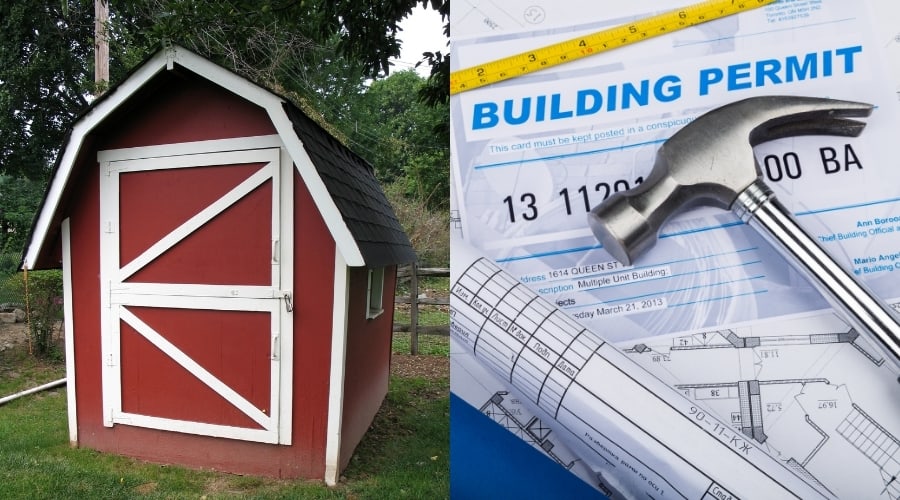Sheds are moderately expensive investments, so you don’t want to throw yours away. Ranging from a few hundred dollars to thousands, getting a shed installed is still a smart move.
Whether it’s additional storage for tools or gardening goodies, you may someday have to relocate. Do you need a permit to move a shed?
Table of Contents
Do I Need A Permit To Move A Shed
In most cities, you do need a permit to move a shed. Each city and state have their own ordinances that must be followed regarding permits to move a structure like a shed. In some cities, a small 6ft x 8ft shed can be moved with no trouble, and in other cities larger sheds can be moved with no specific regulations.
City Regulations To Move A Shed
City regulations vary widely from one to the next. Moving into or out of a new city can change the permit requirements and the penalties for failing to obtain a permit to move your shed.
For example, some cities offer a minimum size limit, under which you don’t need a permit. Others may have a cost limit on the project before you need a permit.
According to World Population Review, “As of 2018, there are 19,495 incorporated cities, towns and villages in the United States.” You have to ask your specific city to obtain the correct information.
Why would a city have regulations to move a shed? Isn’t your property a place you can do what you want? There are some rules to having property and building, even when it’s just moving an existing building, and they exist for good reasons.
Most cities have ordinances forbidding sheds and other structures to be too near a property line. This is because it risks encroaching on your neighbors’ property.
By obtaining a permit, the city knows where you are moving the shed. This can also help prevent dangerous buildings that are not up to code and even assist first responders like firefighters in an emergency.
A city can also rezone, or someone with a larger property may want to break their big parcel into smaller pieces.
Though it’s relatively rare, these can result in an easement becoming necessary. After all, everyone has the right to access their property, even when it’s behind yours.
When you have buildings where your property borders another, it’s not fair to the other property owner with whom you’d otherwise share the easement.
You both have to allow the new third property owner access to their land. The easiest way to do this is via a narrow path or drive between two existing properties.
State Regulations To Move A Shed
Like city regulations, state laws vary. Not only do permit requirements change as you cross state borders, but other factors can also affect your move.
There are different state standards for how wide vehicles and their loads can be when traveling on different roads.
Since sheds can often reach up to twelve feet wide, the standard right over the border could be very different from the place where you are coming from.
The type and number of markings on a vehicle transporting a shed change, as does the necessary documentation.
In Connecticut, a house is defined as ” any dwelling, building, or other structure in excess of 15 feet in width.” This can include sheds even if you don’t plan to live in one.
North Carolina requires Wide Load permits for anything at or over twelve feet, and they cannot move sheds over eleven feet tall.
Where To Locate Local Requirements
There are several ways to locate the local requirements. If you’re working with a contractor, they will likely assist you in getting the correct forms.
Likewise, the DMV can help you get permits for large moves insofar as they relate to the vehicles carrying the shed.
For other government offices and local permitting boards, check out the websites listed below.
- If you aren’t in a city or pass through tribal land on your move, check out this site: https://www.usa.gov/local-governments
- Search government agencies by type here: https://www.usa.gov/agencies
- For government offices by state and city name, try: http://officialcitysites.org
- You can find general government website information at: https://www.state.gov/selected-u-s-government-information-web-sites
Most of the websites above will lead you to the state, county, or city website you need. These websites will have portals for email contact, which will likely take longer.
However, if you are in a rush, you can find phone numbers and hours of operation. Keep in mind, government offices are closed on holidays and weekends.
Once you have found the right office to get the permits for your area or move, you will still need to submit paperwork. There may also be fees for the permits.
This is not an instantaneous process. It can take days or even weeks to get the right permits.
Plan to apply in advance and ask if there’s an expedited form and fee if you need to rush the work. Not every area offers expedited permits, but some do.
Like getting a passport quickly, you can expect a considerable fee hike if expedited service exists.
Are There Any Fines If You Don’t Get A Permit
Not only are you likely to get a fine for moving a shed without a permit, but there are other penalties as well.
In some states, if you are caught driving a shed down a road without a permit, you can be pulled over and may not be allowed to get underway again until you have the right paperwork. It’s not hard to see how that could go badly for you very quickly.
What if you only need to slide it a few dozen feet in your own yard? Sadly, this too may require a permit. You are a little less likely to get caught. Still, property inspectors and tax assessors will likely come out to your land eventually.
If your shed or another building is somewhere it’s not supposed to be you can be forced to move it or tear it down.
Regrettably, you may not get a choice about which one, and that is on top of the fee for moving things without a permit. The amount of the fee and how much time you have to take action depends on where you live.
Helpful Tips To Know If A Permit Is Needed To Move A Shed
There are many considerations for moving a shed. When you already have a shed, likely, you won’t have to deal with things like height restrictions and building permits, but other aspects of the move need permits.
Here are some helpful tips to know if a permit is needed to move a shed.
- Does your shed need electrical wiring? You probably need a permit to move it when the answer is yes because you need to run electric lines.
- HOA’s often have more stringent requirements for where you can place a shed and how you may use it.
- You may need to contact the local zoning department if anyone will be living in the shed or if you conduct any type of business there.
- Some states such as Florida restrict the use of sheds as homes or businesses.
Final Thoughts
There’s enough to handle when you plan to move a shed already. From getting the materials to smoothing the path and pouring a new pad, it’s all too easy to get caught up in other details and forget you might need a permit.
Unfortunately, laws and building codes change regularly. What type of projects require permits, and the fines for failing to obtain them all depend on where you live.
However, a contractor or the local permitting board should have all the information you need to move your shed legally. Please don’t skip this vital step in the process.

